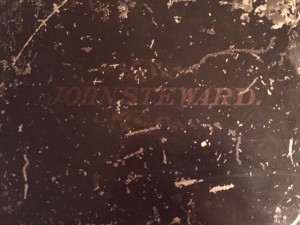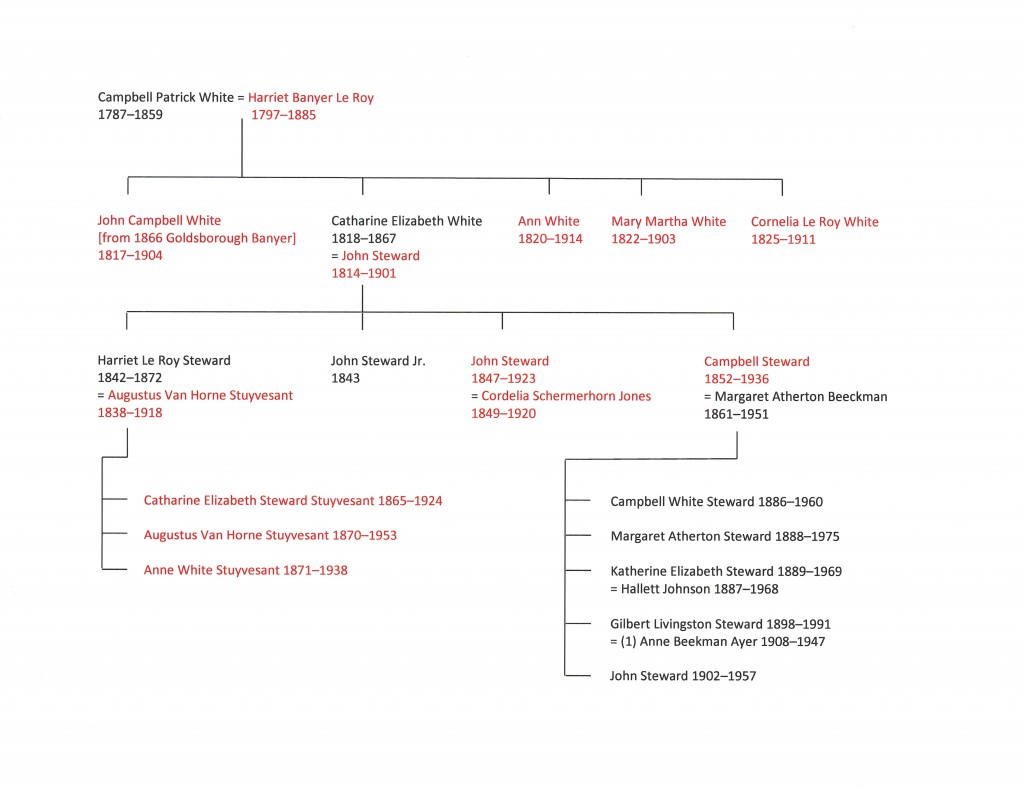 My grandfather died almost 25 years ago, and sometime before that he gave me a box of “family papers.” The box itself is rather striking: a metal strong box, easily portable, with my great-great-grandfather John Steward’s name stenciled on top in fading paint. Inside the box are not just family papers, but intriguing (and, of course, unidentified) daguerreotypes and examples of other early photographic processes, along with materials treating the family of my great-grandmother, Margaret Atherton (Beeckman) Steward (1861–1951).
My grandfather died almost 25 years ago, and sometime before that he gave me a box of “family papers.” The box itself is rather striking: a metal strong box, easily portable, with my great-great-grandfather John Steward’s name stenciled on top in fading paint. Inside the box are not just family papers, but intriguing (and, of course, unidentified) daguerreotypes and examples of other early photographic processes, along with materials treating the family of my great-grandmother, Margaret Atherton (Beeckman) Steward (1861–1951).
By and large, though, the papers in the box relate to the household and family of my great-great-grandparents, John Steward (1814–1901) and Catharine Elizabeth White (1818–1867). They reflect the winnowing process by which Catharine’s children and grandchildren became the sole representatives of Catharine’s parents, Campbell Patrick White (1787–1859) and Harriet Banyer Le Roy (1797–1885), as well as the expanded nuclear family over which Harriet White presided, including her son, daughters, son-in-law, grandchildren, grandson-in-law and granddaughter-in-law, and great-grandchildren.
I thought it might be interesting to go through the box, taking out and examining some of the treasures it contains. Among them: the only image I have ever seen of my great-great-grandfather Gilbert Livingston Beeckman (1824–1874); early deeds associated with my great-great-great-grandfather John Steward (1777–1854), including the purchase of his first New York City house on Pearl Street; and the estate papers of my great-great-great-uncle and aunts, the unmarried siblings of Catharine White Steward.

The chart above (with the members of Mrs. White’s household on West Twenty-first Street in Manhattan depicted in red type) has at least one curious feature: Mrs. White’s only surviving son, John Campbell White, changed his name as an adult to become Goldbsorough Banyer. Why?
Thereby hangs a tale, one could say, as Mrs. White was the granddaughter of Goldsbrow Banyar (1724?–1815), Deputy Secretary of the Province of New York. In early middle age he married Elizabeth (Naden) Appy; of their children, one was Goldsborough Jr., who married the daughter of John Jay and died young, and another was Martha (Banyer) Le Roy. With the deaths of Goldsbrow’s sons and namesake grandson, he was filled with the understandable ambition to leave not just his substantial wealth but his name within the family, as various drafts of his will – updated to reflect the successive deaths – attest. Following her father’s death, Martha Le Roy’s son Goldsborough Banyer Le Roy (1802–1866) reversed the order of his middle and last names; he was known thereafter as G. Le Roy Banyer.
As Uncle Le Roy never married, the name problem continued. Harriet White’s son John Campbell White (named for his paternal grandfather) was an obvious candidate for a name change, the more so as he had three first cousins in Baltimore named John Campbell White! (Baltimore families like the Whites handled the problem by designating cousins in this manner: Joseph White’s son John was John C. White of J., Henry White’s son was John C. White of H., and Stevenson White’s son was John C. White of S.)
Following Le Roy Banyer’s death, Uncle John White became Uncle Goldsborough Banyer. With the exception of my great-great-grandmother, none of Harriet White’s children married, and the Banyer name once again faced extinction. What to do?
My grandfather told the story that his father, Campbell Steward (1852–1936), was approached on the subject of changing his name (or perhaps the names of one of his three sons) to Goldsborough Banyer. In due course, the Steward name would face extinction in our line – until my grandparents married and had three sons – as the Whites, Le Roys, and Banyers in our line had failed before them. Was my great-grandfather tempted enough by the prospect of Uncle Goldsborough’s wealth to follow in this not entirely prepossessing tradition?
“Well,” my grandfather drawled, “we were awfully hard up!”
Continued here.
Interesting, my brother was offered chances to change his name, switching his middle name to become a surname; my mother’s maiden name would end otherwise. There was money involved. Actually the surname continues but with the children of an adopted son who took the name at his adoption.
I may have commented on this earlier but I find it interesting that your tree calls the family Beeckman while my Livingston genealogy says Beekman throughout. Perhaps the Beekman Arms [hotel] in Rhinebeck NY should check to see what is the original spelling.
Howland, there are at least two distinct families named Beeckman/Beekman, and my grandfather was descended from both. His mother was Margaret Atherton Beeckman, a descendant of Marten Hendricksz Beeckman of Fort Orange/Albany. Through the Livingstons, Margaret was also descended from William Beekman of New Amsterdam/New York. My paternal grandmother, Anne Beekman Ayer, was my grandfather’s seventh cousin.
such a cliffhanger!
!!
I was so distracted by the idea of a bunch of unidentified photos that for the rest of the article, I couldn’t stop thinking about them. Maybe you can feature them sometime – ?
Oh, yes, I mean to go through the box’s contents, including the mystery photos, and report on it here.
Excellent!
I, too, inherited a black metal box from my gr-grandfather. It had some good information, but not the answers. He too was searching in Connecticut for information on his grandfather’s family. There was the comment from a cousin about a family Bible, but that was never found.
I love the chart in this interesting article. How has it been made? Was a special program used? Any information would be wonderful.
It can easily be made using Word. I laid out the family as I wanted to see it, then used the Insert/Shapes functions to create straight lines and make the chart. Then I added color as a last step, printed it on our Canon, scanned it as as JPEG, and uploaded it with WordPress.
Not relying on a program gives me the flexibility to create the effects I want to see, and Word is both flexible and generous in the tweaks one can make!
Hi Scott. What a wonderful post. I also have been the recipient of papers my grandparents and great-grandparents possessed – land deeds, hand-drawn maps and other artifacts from where my Palatine immigrants settled, in York County, Pennsylvania during the early 18th century. We have a published genealogy of that part of my family; but these records were in a wooden traveling desk with compartments beneath. My father gave it to me on one of my recent trips home. A priceless treasure of my own family history.
Thanks, Christopher!
Great tale Scott!
Thanks, Jeff!
I inherited family documents from my father’s side, but they were in a beautifully carved Asian box belonging to my mother. Two of her cousins were in the Merchant’s Marine before and during WW II, and one brought this heavily carved box back for her. So the documents came to me in a cardboard box. Someone else in the family, don’t know who, will end up with the box. I’d love to have it, but the papers have more genealogical importance, so I ought to be grateful I got those!
So far I haven’t encountered a case like yours where someone changed their name to keep the family money. My family doesn’t ever seem to have had much money, in any branch, to make this an issue! And being Norwegian on my mother’s side, they used the patronymic naming system, where names changed every generation in any case. My father’s family were partly from New Netherland, where the same system held.
Thanks for your interesting posts.
Thanks, Doris!